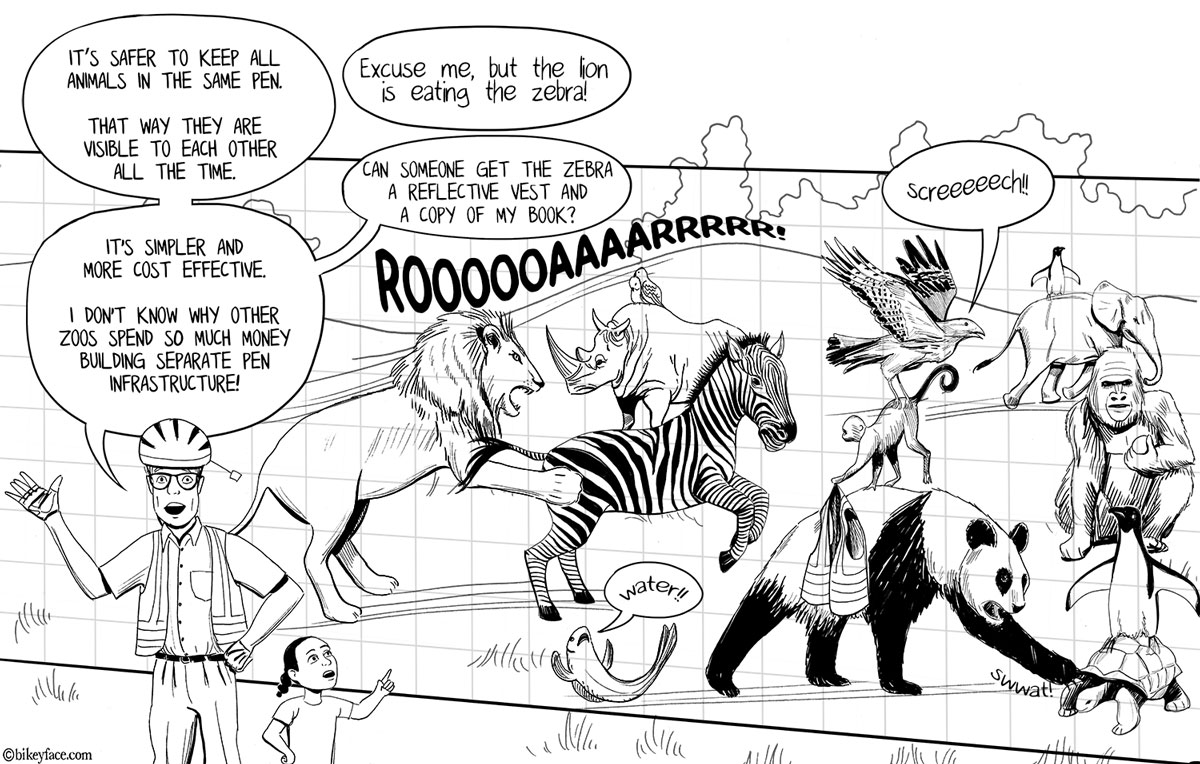Boundary Channel Drive Interchange Project – Public Meeting
Our Community › Forums › General Discussion › Boundary Channel Drive Interchange Project – Public Meeting
- This topic has 52 replies, 17 voices, and was last updated 8 years, 8 months ago by
paulg.
-
AuthorPosts
-
June 23, 2015 at 3:15 pm #1032742
 chris_sParticipant
chris_sParticipantTonight!
June 24, 2015 at 1:10 am #1032815 chris_sParticipant
chris_sParticipantThe 3 concept plans are up in the “image gallery” section of the project website. Click to enlarge. It’s not a choice between the three, the final design will likely take the best bits and pieces from each design. There are four main areas to pay attention to in each design, the Connector Road intersection, the west rotary and how it connects, the east rotary and how it connects and the intersection with the future long bridge park aquatics center.
Things that jump out at me:
Concept 1:
By far the best from a “let’s not have the trail cross a bunch of highway ramps”Concept 2:
I basically hate everything about this concept.Concept 3:
This is the Connector Road intersection that I like best. It’s just a normal, understandable, signalized intersection. Seems like the safest option to cross as a pedestrian, etc.June 24, 2015 at 12:48 pm #1032822bobco85
ParticipantHere are the images for the 3 concept plans for those that don’t want to venture off the forum.
June 24, 2015 at 1:15 pm #1032829DismalScientist
ParticipantDoes the traffic volume on the road really justify having segregated bike paths underneath 395? Besides a trail connection, I would think the only thing needed is a good paving job and lights under the bridge at 395.
All the proposal look to me to make it difficult to just turn from/to the road to/from the trail.
June 24, 2015 at 1:25 pm #1032830bobco85
ParticipantMy opinion comes from a perspective of a cyclist who rides on the road through this area primarily on evenings/nights/weekends a.k.a. off-peak times.
I’ll break my opinion of the concepts into 3 separate parts: Connector Rd/Boundary Channel Dr intersection, West traffic circle, and East traffic circle.
Connector Rd/Boundary Channel intersection:
– I like Concept 1 the most here because I don’t think a stoplight is necessary there (this may show my ignorance of the situation during rush hour).West traffic circle:
– I like Concept 3 the most because it splits the on-ramp and off-ramp to separate sides, meaning cyclists/pedestrians would only have to cross 1 road regardless if they were on the north or south side of the circle.
– I think Concept 1 would be most convenient for accessing the MVT, but I don’t like the bunching of the on-ramp and off-ramp on the south side of the circle.
– In general, I’m glad they are foregoing the cloverleaf design for I-395 here.East traffic circle:
– I like Concept 2 the most because it keeps things simple by routing all Long Bridge Drive traffic around the circle.All in all, I’m glad that they will be taking parts of each of the 3 concept designs, as none of the 3 are perfect in my mind. Haha, I’m actually more excited about the idea that the I-395 underpass might actually get repaved!
June 24, 2015 at 1:41 pm #1032832PotomacCyclist
ParticipantI know at least some of the military personnel at the Pentagon go for runs around the Pentagon Reservation, including along Boundary Channel Drive. I don’t ride on that road too often (mostly because the road doesn’t have a direct connection to the MVT today), but I would imagine that many would run between the Pentagon and Long Bridge Park and/or the MVT. Many civilians would also welcome an easier walking or running path between the park and MVT. I know I would. Both the park and the trail see a lot of use, from people on bikes, people running, people walking, people roller-blading, …
I wasn’t able to stay for the entire meeting so I haven’t looked at the concepts in depth. But I’ll look it over more carefully by the weekend and send a comment to the project website.
June 24, 2015 at 3:04 pm #1032836scoot
Participant@DismalScientist 118860 wrote:
Does the traffic volume on the road really justify having segregated bike paths underneath 395? Besides a trail connection, I would think the only thing needed is a good paving job and lights under the bridge at 395.
All the proposal look to me to make it difficult to just turn from/to the road to/from the trail.
+1
My recent experience with this area is off-peak, but I sometimes went through during rush hour a few years back when I was using the slug lines to go south. Peak or off-peak, I have never seen much activity at this interchange.
All three designs make it unnecessarily difficult (i.e. sharp turns at crosswalks) to transition between the MVT connection and the BC roadway. Concept 1 is best, because it eliminates the offramps right next to the connector, but it still needs a direct connection into and out of the roundabout. I’d prefer to see the trail connector function as an equal participant in the roundabout (something like the pink lines drawn here, showing how one could get to/from Long Bridge Park):
[ATTACH=CONFIG]8968[/ATTACH]
And of course, build all the orange sidewalks also so that people can choose to stay off-street if they prefer.
June 24, 2015 at 4:22 pm #1032858 Steve OParticipant
Steve OParticipant@DismalScientist 118860 wrote:
Does the traffic volume on the road really justify having segregated bike paths underneath 395?
Not for you and not for me, but we’re not building facilities for the people who ride bikes now, we are building them for the people who don’t, but might. I like #1, because it allows one to travel between Long Bridge Park and MVT with only a single crossing going either way. If we don’t create a 2-way bicycle route under 395 then the route from MVT to Long Bridge might seem uncomfortable to newbie and tentative riders.
If we have the opportunity to add to the inventory of segregated facilities, then we should take it. Traveling under a giant interstate highway in a completely separated and protected space just feels nicer to most riders–even if there aren’t very many cars on the road next to it.
I also like how #1 eliminates all the paved roads on the north side, freeing up open space that could either become some sort of usable field or perhaps turned into an accessible natural area.
June 24, 2015 at 4:24 pm #1032860Tim Kelley
Participant@Steve O 118892 wrote:
Not for you and not for me, but we’re not building facilities for the people who ride bikes now, we are building them for the people who don’t, but might.
…
If we have the opportunity to add to the inventory of segregated facilities, then we should take it.
So good. Thank you.
June 24, 2015 at 4:46 pm #1032865DismalScientist
Participant@Steve O 118892 wrote:
Not for you and not for me, but we’re not building facilities for the people who ride bikes now, we are building them for the people who don’t, but might.
If we have the opportunity to add to the inventory of segregated facilities, then we should take it. Traveling under a giant interstate highway in a completely separated and protected space just feels nicer to most riders–even if there aren’t very many cars on the road next to it.
Putting segregated facilities on both sides of the underpass has the effect of narrowing the lanes under the underpass, potentially to the point where cars can no longer make safe passes of cyclists in the road.
Segregated facilities may suggest to drivers that cyclists do not rightfully belong in the road. If I am going southbound on BC through to Long Bridge road, I don’t want the expectation that I should take the path on the right side under the bridge as this will force me to cross the ramps to 395 at two crosswalks. I would rather stay in the street, which is certainly safer for me and, frankly, I think safer for a novice cyclist as well (particularly if the street is wider).
As I have stated before, a lot of the segregated infrastructure looks an awful lot like sidewalks, with all the attendant dangers at intersections. “Protected” bike lanes generally involve impaired visibility of cyclists by drivers, including misperception of speed at intersections. I dread riding in the new Hayes Street PBLs and I certainly hate turning across them (while driving) into Virginia Highlands park.
To encourage more cycling, I would emphasize parallel quiet residential streets rather than protected bike lanes if possible.
June 24, 2015 at 4:54 pm #1032867DaveK
Participant@DismalScientist 118899 wrote:
Putting segregated facilities on both sides of the underpass has the effect of narrowing the lanes under the underpass, potentially to the point where cars can no longer make safe passes of cyclists in the road.
Segregated facilities may suggest to drivers that cyclists do not rightfully belong in the road. If I am going southbound on BC through to Long Bridge road, I don’t want the expectation that I should take the path on the right side under the bridge as this will force me to cross the ramps to 395 at two crosswalks. I would rather stay in the street, which is certainly safer for me and, frankly, I think safer for a novice cyclist as well (particularly if the street is wider).
As I have stated before, a lot of the segregated infrastructure looks an awful lot like sidewalks, with all the attendant dangers at intersections. “Protected” bike lanes generally involve impaired visibility of cyclists by drivers, including misperception of speed at intersections. I dread riding in the new Hayes Street PBLs and I certainly hate turning across them (while driving) into Virginia Highlands park.
To encourage more cycling, I would emphasize parallel quiet residential streets rather than protected bike lanes if possible.
 June 24, 2015 at 4:58 pm #1032870
June 24, 2015 at 4:58 pm #1032870 lordofthemarkParticipant
lordofthemarkParticipantI am having trouble getting a sufficiently detailed view of the plans. Do any actually show bike lanes? I think they just show sidepaths, which are necessary for pedestrians and (most) runners. I suppose you could have narrower sidepaths, which might serve to encourage more cautious newbie cyclists to take the lane (but in my experience A. They still won’t and B. when they do, they will do so improperly) and would make it easier for cars to pass cyclists in lane (because of wider general travel lanes – but at the expense of a less pleasant pedestrian experience, and possibly higher traffic speeds in a wider lane.
June 24, 2015 at 5:01 pm #1032871 lordofthemarkParticipant
lordofthemarkParticipant@DismalScientist 118899 wrote:
To encourage more cycling, I would emphasize parallel quiet residential streets rather than protected bike lanes if possible.
Absolutely. Works very well in some parts of Arlington, and in DC. Now, are you onboard for massive use of eminent domain to connect up all the cul de sacs in Fairfax, west Alexandria, and even some parts of South Arlington, which mean the quiet residential streets don’t link up?
https://www.strava.com/activities/274908374
June 24, 2015 at 5:45 pm #1032874 chris_sParticipant
chris_sParticipant@lordofthemark 118904 wrote:
I am having trouble getting a sufficiently detailed view of the plans. Do any actually show bike lanes? I think they just show sidepaths, which are necessary for pedestrians and (most) runners. I suppose you could have narrower sidepaths, which might serve to encourage more cautious newbie cyclists to take the lane (but in my experience A. They still won’t and B. when they do, they will do so improperly) and would make it easier for cars to pass cyclists in lane (because of wider general travel lanes – but at the expense of a less pleasant pedestrian experience, and possibly higher traffic speeds in a wider lane.
Bike Lanes on Long Bridge Drive, 14′ wide trail along Boundary Channel to connect up to the Humpback Bridge Trail.
Space for the trails comes from taking Boundary Channel from 4 lanes down to 2 under 395 since it doesn’t get near enough traffic to justify four lanes.
June 24, 2015 at 7:10 pm #1032889 Steve OParticipant
Steve OParticipant@DismalScientist 118899 wrote:
Segregated facilities may suggest to drivers that cyclists do not rightfully belong in the road.
And non-segregated facilities already suggest to most people that they shouldn’t be riding a bicycle.
-
AuthorPosts
- You must be logged in to reply to this topic.